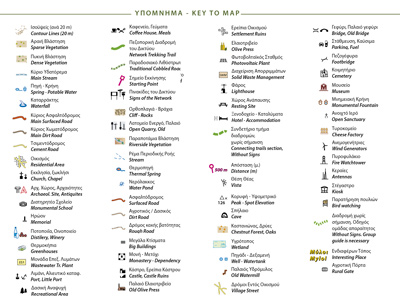- DISTANCE: klm
- DISTANCE RUNTIME:
- ALTITUDE (min): (max):
- ALTITUDE DIFFERENCE: m
- AREA MORPHOLOGY:
- ROUTE VEGETATION:
- MONUMENTS OF HISTORY AND CULTURE:
- CONNECTIONS WITH OTHER ROUTES OF THE NETWORK:
- ΠΡΟΣΒΑΣΕΙΣ και ΔΙΕΥΚΟΛΥΝΣΕΙΣ:
The ground of Lesvos Island has been marked since ancient times by an extensive network of paths. Endeavouring for communication between villages and small settlements, access to agricultural and grazing areas, backcountry locations and sacred grounds, the habitants of the island throughout the historical periods kept improving these ‘country roads’ making them safer and more passable by the people using them.
The course of each path has been defined by specific parameters as it happens in all countries. The ease of movement in areas with dense forests or shrubs, the safe and comfortable crossing on rocky ground, the communal land between properties, all this ‘dictated’ the boundaries of the paths. Of them, some are still in use today and others have been abandoned or blocked, or even forgotten by the old users, as now farmers and pilgrims are served by dirt roads that were developed in the rural areas. Unfortunately there are also cases of roads built over the old paths, and yet, in many rural areas of the island the need for paths exists even today, and these paths are well maintained so, apart from the local residents-permanent users, they are walked on and used by trekking travellers.
Trekking Tourism is flourishing in Lesvos thanks to its varied natural environment, the interesting natural terrain and geological formations, the rich flora and fauna and the monuments of both Nature and Civilisation dotting every part of the island.
The existing paths is the basic structure for accessing all of the above, which is why the local cultural and developmental bodies, local administrations, the State but also private individuals involved in the alternative types of tourism, are proactive in creating trekking routes.
For the visitors who want to get to know the island on foot, the possibilities are many. Quite separate to the paths, there is a dense network of rural and forest roads from which these paths start, or else the trekker can use them as sections connecting him to points of his own planned route.
As from region to region of Lesvos the landscape and the relief vary greatly, there are many categories of trekking. Trekkers in pairs, families, small or large groups with a guide become acquainted with mountain and hard to access areas, forested slopes, passages once used by the mule men and the woodcutters, ridges and plateaus with uninterrupted view, gurgling streams, cobblestone trails and stonewalls in the olive grove or with the flowing colours of the chestnut forest. In the constellation of the so many traditional villages with the old fountains and the majestic churches, we ought to add the cultural assets of several important locations, where the people of the past were laying the foundation of the local culture. From the ancient temples that have been discovered and promoted, to the humble bench. From the well maintained chapels to the open holy iconostases with the parts of unidentified buildings that might exist under the footsteps of the unsuspecting visitors. From the giant mountain sycamores to the lone wind-beaten little tree. Everything whispers to the trekker in a language understood only when walking.





